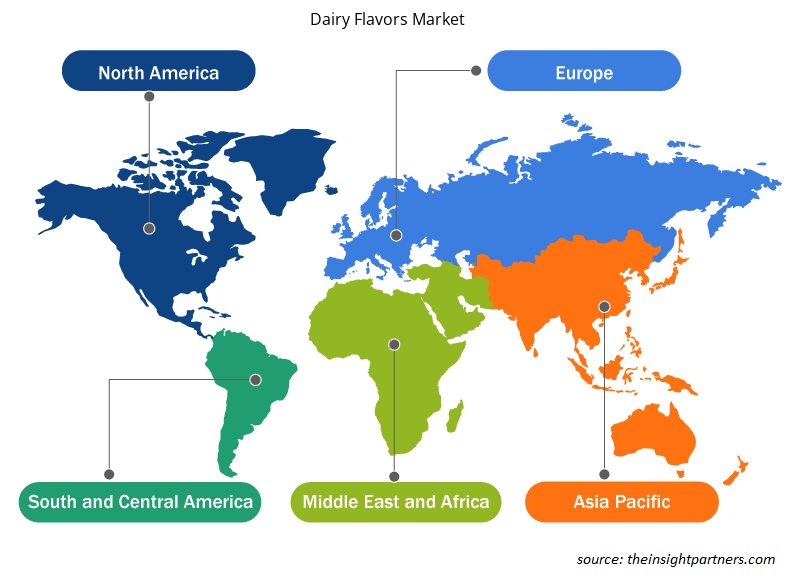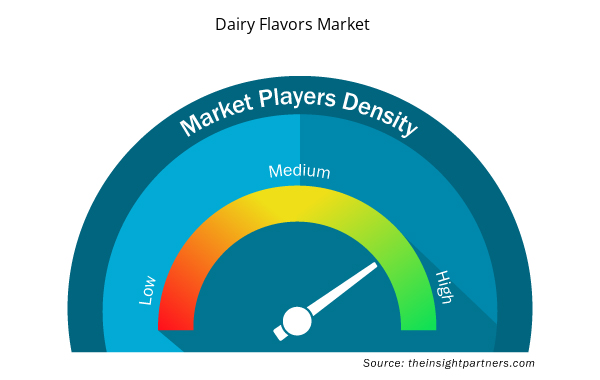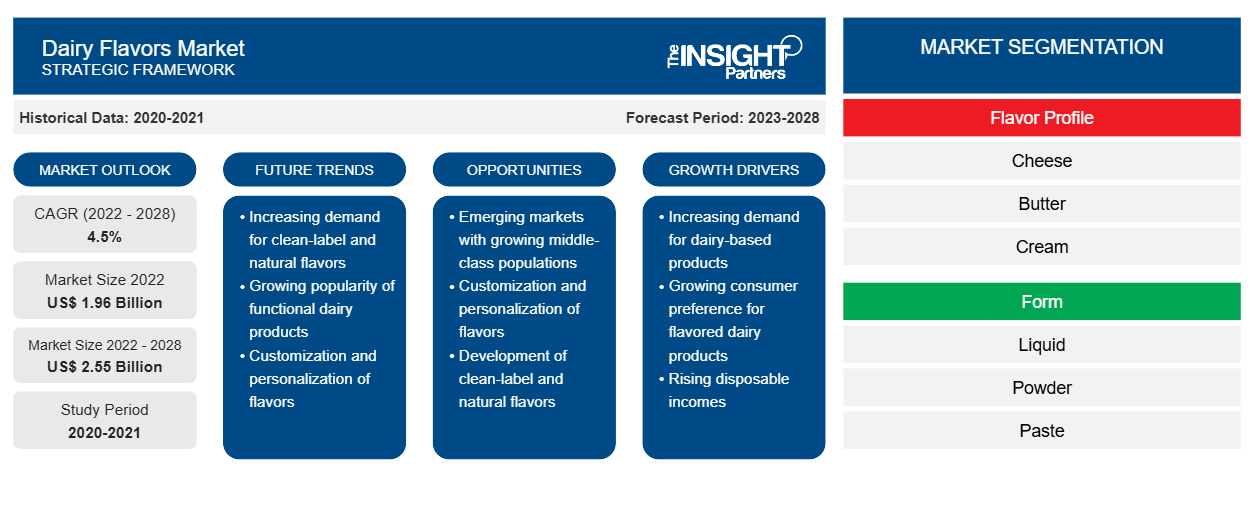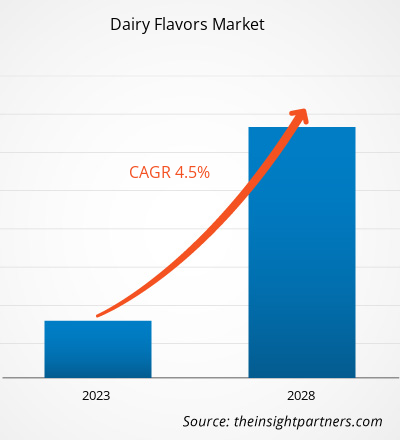Der Markt für Milcharomen soll von 1.962,45 Millionen US-Dollar im Jahr 2022 auf 2.552,19 Millionen US-Dollar im Jahr 2028 wachsen; von 2022 bis 2028 wird mit einer durchschnittlichen jährlichen Wachstumsrate von 4,5 % gerechnet.
Milcharomen sind Geschmacksstoffe, die verschiedenen Lebensmitteln und Getränken zugesetzt werden, um den Geschmack von Milchprodukten wie Butter, Käse, Sahne und Milch zu verleihen. Milcharomen werden in der Lebensmittel- und Getränkeindustrie immer beliebter, da sie dabei helfen, einen Milchgeschmack zu verleihen, ohne den Kalorien- oder Fettgehalt des Produkts zu erhöhen. Milcharomen werden aus Milchprodukten wie Milch, Butter, Käse und Sahne verarbeitet und hergestellt und sind in flüssiger, Pulver- und Pastenform erhältlich. Diese Aromen sollen den Geschmack und die Intensität verschiedener Lebensmittel verbessern, indem sie ihnen eine Reihe von Geschmacksprofilen wie buttrig, käsig, cremig sowie verschiedene andere süße und herzhafte Geschmacksrichtungen verleihen. Milcharomen werden in verschiedenen Lebensmitteln wie Back- und Süßwaren, süßen und herzhaften Snacks, Suppen und Saucen, Dips und Dressings sowie gefrorenen Desserts verwendet.
Im Jahr 2021 hatte der asiatisch-pazifische Raum den größten Anteil am Markt für Milcharomen und wird im Prognosezeitraum voraussichtlich die höchste durchschnittliche jährliche Wachstumsrate verzeichnen . Das Marktwachstum in dieser Region ist hauptsächlich auf das steigende Gesundheitsbewusstsein und den zunehmenden Fokus auf schmackhaftes Essen in Ländern wie Indien, China und Japan aufgrund der steigenden verfügbaren Einkommen zurückzuführen. Die Verbraucher sind in diesen Ländern bereit, höhere Preise für Milcharomen zu zahlen. Indien ist einer der am schnellsten wachsenden Märkte im asiatisch-pazifischen Raum, wo die Verbraucher keine Kompromisse beim Geschmack und den Gesundheitsfaktoren der Lebensmittel eingehen möchten. Es besteht eine enorme Nachfrage nach regionalen und traditionellen Aromen vom indischen Subkontinent, was das Marktwachstum ankurbelt.
Passen Sie diesen Bericht Ihren Anforderungen an
Sie erhalten kostenlose Anpassungen an jedem Bericht, einschließlich Teilen dieses Berichts oder einer Analyse auf Länderebene, eines Excel-Datenpakets sowie tolle Angebote und Rabatte für Start-ups und Universitäten.
- Holen Sie sich die wichtigsten Markttrends aus diesem Bericht.Dieses KOSTENLOSE Beispiel umfasst eine Datenanalyse von Markttrends bis hin zu Schätzungen und Prognosen.
Auswirkungen der COVID-19-Pandemie auf den Markt für Milcharomen
Vor der Pandemie waren die wachsende Nachfrage nach verarbeiteten Lebensmitteln und die zunehmende Nachfrage der Verbraucher nach einer Vielfalt an Aromen und Geschmacksrichtungen der Produkte die Schlüsselfaktoren, die das Wachstum des Marktes für Milcharomen ankurbelten. Der Markt für Milcharomen wurde von der Lebensmittel- und Getränkeindustrie angetrieben, die eine Vielzahl von Aromen in ihre Produkte einarbeitete. Darüber hinaus waren die Hinwendung der Verbraucher zu natürlichen Aromen und der erhöhte Konsum von verzehrfertigen Produkten in der Bevölkerung weitere Faktoren, die das Marktwachstum positiv beeinflussten. Nach dem Ausbruch der COVID-19-Pandemie im Jahr 2020 standen die Branchen jedoch vor beispiellosen Herausforderungen, darunter Lieferkettenbeschränkungen aufgrund landesweiter Lockdowns , Handelsverbote und Reisebeschränkungen. Die Unterbrechungen der Lieferketten führten zu einem Mangel an Rohstoffen, der die Produktion und den Vertrieb verschiedener Produkte beeinträchtigte und zu höheren Preisen führte.
Im Jahr 2021 nahmen viele Volkswirtschaften ihren Betrieb wieder auf, als die Regierungen mehrerer Länder Lockerungen der zuvor verhängten Beschränkungen ankündigten, was dem globalen Markt Auftrieb gab. Darüber hinaus durften die Hersteller mit voller Kapazität arbeiten, was ihnen half, die Lücke zwischen Angebot und Nachfrage sowie andere Auswirkungen zu überwinden. Da zahlreiche Bürger vieler Länder bis 2021 vollständig geimpft waren, konzentrierten sich die Hersteller von Milcharomen darauf, ihre Produktion zu steigern, um ihre Geschäfte wiederzubeleben.
Markteinblicke
Strategische Entwicklungen wichtiger Akteure begünstigen Wachstum auf dem Markt für Milcharomen
Im Juni 2020 erweiterte Edlong sein Segment für natürliche Aromen auf Milchbasis um eine Linie hochintensiver Käsesorten und fermentierter Profile zur Verwendung in Saucen, Dressings und Dips. Im Mai 2021 erwirbt Synergy Flavors Innova Flavors von Griffith Foods Worldwide. Diese Übernahme bietet Synergy-Kunden erhebliche Vorteile, da sie Zugang zu einer bewährten Vielfalt an Aromen erhalten, um der wachsenden Nachfrage nach natürlichen Aromen und herzhaften Zutaten gerecht zu werden. Solche strategischen Entwicklungen wichtiger Marktteilnehmer dürften das Wachstum des Marktes für Milcharomen ankurbeln. Darüber hinaus sind einige der wichtigsten Akteure in der Region an Strategien wie Fusionen und Übernahmen beteiligt, um ihre geografische Präsenz auszuweiten.
Einblicke in Geschmacksprofile
Basierend auf dem Geschmacksprofil ist der Markt für Milcharomen in Käse , Butter, Sahne und andere unterteilt. Das Käsesegment hatte 2021 den größten Marktanteil und wird im Prognosezeitraum voraussichtlich die höchste durchschnittliche jährliche Wachstumsrate verzeichnen. Die Popularität von Käsearomen beruht auf seiner Verwendung in Popcorn, Kartoffelchips, Keksen, Crackern, Dips & Brotaufstrichen und Saucen, um nur einige zu nennen. Die steigende Nachfrage nach Lebensmitteln, wachsende Einzelhandelsgeschäfte und die zunehmende Vorliebe für Fast Food verstärken den Bedarf an Käsearomen.
Anwendungseinblicke
Basierend auf der Anwendung ist der Markt für Milcharomen in Backwaren und Süßwaren, Milchprodukte und gefrorene Desserts , Suppen und Soßen, Dressings, Dips und Aufstriche, Getränke und andere unterteilt. Brot, Kekse, Kuchen und Füllungen gehören zu den wichtigsten Back- und Süßwarenanwendungen von Milcharomen. Süßwarenhersteller verwenden in ihren Produkten zunehmend natürliche Aromen. Milchbasierte Aromen werden zunehmend in Backwaren wie Keksen und Kuchen verwendet.
Jeneil, Flavorjen, The Edlong Corporation, Givaudan SA, Kerry Group, Sensient Technologies, Symrise, Synergy Flavors, Bluegrass Ingredients Inc. und Flavorade India gehören zu den wichtigsten Akteuren auf dem Markt für Milcharomen. Diese Unternehmen konzentrieren sich hauptsächlich auf Produktinnovationen, um ihre Marktgröße zu erweitern und aufstrebenden Markttrends zu folgen.
Regionale Einblicke in den Markt für Milcharomen
Die regionalen Trends und Faktoren, die den Markt für Milcharomen im Prognosezeitraum beeinflussen, wurden von den Analysten von Insight Partners ausführlich erläutert. In diesem Abschnitt werden auch die Marktsegmente und die Geografie für Milcharomen in Nordamerika, Europa, im asiatisch-pazifischen Raum, im Nahen Osten und Afrika sowie in Süd- und Mittelamerika erörtert.

- Holen Sie sich die regionalen Daten für den Markt für Milcharomen
Umfang des Marktberichts über Milcharomen
| Berichtsattribut | Details |
|---|---|
| Marktgröße im Jahr 2022 | 1,96 Milliarden US-Dollar |
| Marktgröße bis 2028 | 2,55 Milliarden US-Dollar |
| Globale CAGR (2022 - 2028) | 4,5 % |
| Historische Daten | 2020-2021 |
| Prognosezeitraum | 2023–2028 |
| Abgedeckte Segmente | Nach Geschmacksprofil
|
| Abgedeckte Regionen und Länder | Nordamerika
|
| Marktführer und wichtige Unternehmensprofile |
|
Marktteilnehmerdichte für Milcharomen: Auswirkungen auf die Geschäftsdynamik verstehen
Der Markt für Milcharomen wächst rasant, angetrieben durch die steigende Nachfrage der Endverbraucher aufgrund von Faktoren wie sich entwickelnden Verbraucherpräferenzen, technologischen Fortschritten und einem größeren Bewusstsein für die Vorteile des Produkts. Mit steigender Nachfrage erweitern Unternehmen ihr Angebot, entwickeln Innovationen, um die Bedürfnisse der Verbraucher zu erfüllen, und nutzen neue Trends, was das Marktwachstum weiter ankurbelt.
Die Marktteilnehmerdichte bezieht sich auf die Verteilung der Firmen oder Unternehmen, die in einem bestimmten Markt oder einer bestimmten Branche tätig sind. Sie gibt an, wie viele Wettbewerber (Marktteilnehmer) in einem bestimmten Marktraum im Verhältnis zu seiner Größe oder seinem gesamten Marktwert präsent sind.
Die wichtigsten auf dem Markt für Milcharomen tätigen Unternehmen sind:
- Jeneil
- Geschmacksrichtungen
- Die Edlong Corporation
- Givaudan SA
- Kerry-Gruppe
Haftungsausschluss : Die oben aufgeführten Unternehmen sind nicht in einer bestimmten Reihenfolge aufgeführt.

- Überblick über die wichtigsten Akteure auf dem Markt für Milcharomen
Bericht-Spotlights
- Fortschrittliche Branchentrends im Markt für Milcharomen helfen Unternehmen bei der Entwicklung wirksamer langfristiger Strategien
- Geschäftswachstumsstrategien der Marktteilnehmer für Milcharomen in Industrie- und Entwicklungsländern
- Quantitative Analyse des Marktes von 2022 bis 2028
- Schätzung der weltweiten Nachfrage nach Milcharomen
- Porters Fünf-Kräfte-Analyse zur Veranschaulichung der Wirksamkeit von Käufern und Lieferanten auf dem Markt für Milcharomen
- Aktuelle Entwicklungen zum Verständnis des Wettbewerbsmarktszenarios
- Markttrends und -aussichten sowie Faktoren, die das Wachstum des Marktes für Milcharomen vorantreiben und bremsen
- Unterstützung im Entscheidungsprozess durch Aufzeigen von Marktstrategien, die das kommerzielle Interesse untermauern
- Größe des Marktes für Milcharomen an verschiedenen Knotenpunkten
- Detaillierte Übersicht und Segmentierung des Marktes und der Wachstumsdynamik der Milcharomenindustrie
- Größe des Marktes für Milcharomen in verschiedenen Regionen mit vielversprechenden Wachstumschancen
- Historische Analyse (2 Jahre), Basisjahr, Prognose (7 Jahre) mit CAGR
- PEST- und SWOT-Analyse
- Marktgröße Wert/Volumen – Global, Regional, Land
- Branche und Wettbewerbsumfeld
- Excel-Datensatz



Report Coverage
Revenue forecast, Company Analysis, Industry landscape, Growth factors, and Trends

Segment Covered
This text is related
to segments covered.

Regional Scope
North America, Europe, Asia Pacific, Middle East & Africa, South & Central America

Country Scope
This text is related
to country scope.
Häufig gestellte Fragen
Consumers are shifting their preferences toward more natural and organic food products. They are highly concerned about the ingredients used in processed foods and beverages and are preferring simpler ingredients, free from chemical additives and genetically modified organisms (GMOs). Clean label and organic food products have gained significant traction among the consumers in the region since they are perceived to be healthier than conventional foods. Consumers are willing to pay a higher price for clean label and organic foods. The product development coupled with surging popularity of clean label and organic food products is projected to offer significant growth opportunities to the manufacturers of dairy flavors over the forecast period.
Dairy flavors are processed and manufactured from dairy products such as milk, butter, cheese, and cream and are available in liquid, powder, and paste formats. These flavors are intended to enhance the taste and intensity of various food products by providing them with an array of flavor profiles such as buttery, cheesy, creamy, and several other sweet and savory tastes. Dairy flavors are used in various food products such as bakery & confectionery, sweet & savory snacks, soups & sauces, dips & dressings, and frozen desserts. Thus, the growth of the food & beverages industry, coupled with an increase in the utilization of dairy flavors in a wide range of food products, is significantly driving the dairy flavors market globally
The major players operating in the global dairy flavors market are Jeneil, Flavorjen, The Edlong Corporation, Givaudan S.A., Kerry Group, Sensient Technologies, Symrise, Synergy Flavors, Bluegrass Ingredients Inc., and Flavorade India.
Asia Pacific accounted for the largest share of the global dairy flavors market. Asia Pacific is one of the most significant regions for the dairy flavors market owing to rising health awareness and increasing focus on tasty food in countries such as India, China, and Japan due to the growing disposable incomes.
Based on the category, natural segment is projected to grow at the fastest CAGR over the forecast period. Rising health concerns among consumers and increasing number of product launches has surged the growth of natural dairy flavors segment.
Based on flavor profile, cheese segment mainly has the largest revenue share. The growth of the segment is attributed to availability of variety of flavors and its wide application in various food and beverages application.
Trends and growth analysis reports related to Food and Beverages : READ MORE..
The List of Companies - Dairy Flavors Market
- Jeneil
- Flavorjen
- The Edlong Corporation
- Givaudan S.A.
- Kerry Group
- Sensient Technologies
- Symrise
- Synergy Flavors
- Bluegrass Ingredients Inc.
- Flavorade India
The Insight Partners performs research in 4 major stages: Data Collection & Secondary Research, Primary Research, Data Analysis and Data Triangulation & Final Review.
- Data Collection and Secondary Research:
As a market research and consulting firm operating from a decade, we have published and advised several client across the globe. First step for any study will start with an assessment of currently available data and insights from existing reports. Further, historical and current market information is collected from Investor Presentations, Annual Reports, SEC Filings, etc., and other information related to company’s performance and market positioning are gathered from Paid Databases (Factiva, Hoovers, and Reuters) and various other publications available in public domain.
Several associations trade associates, technical forums, institutes, societies and organization are accessed to gain technical as well as market related insights through their publications such as research papers, blogs and press releases related to the studies are referred to get cues about the market. Further, white papers, journals, magazines, and other news articles published in last 3 years are scrutinized and analyzed to understand the current market trends.
- Primary Research:
The primarily interview analysis comprise of data obtained from industry participants interview and answers to survey questions gathered by in-house primary team.
For primary research, interviews are conducted with industry experts/CEOs/Marketing Managers/VPs/Subject Matter Experts from both demand and supply side to get a 360-degree view of the market. The primary team conducts several interviews based on the complexity of the markets to understand the various market trends and dynamics which makes research more credible and precise.
A typical research interview fulfils the following functions:
- Provides first-hand information on the market size, market trends, growth trends, competitive landscape, and outlook
- Validates and strengthens in-house secondary research findings
- Develops the analysis team’s expertise and market understanding
Primary research involves email interactions and telephone interviews for each market, category, segment, and sub-segment across geographies. The participants who typically take part in such a process include, but are not limited to:
- Industry participants: VPs, business development managers, market intelligence managers and national sales managers
- Outside experts: Valuation experts, research analysts and key opinion leaders specializing in the electronics and semiconductor industry.
Below is the breakup of our primary respondents by company, designation, and region:

Once we receive the confirmation from primary research sources or primary respondents, we finalize the base year market estimation and forecast the data as per the macroeconomic and microeconomic factors assessed during data collection.
- Data Analysis:
Once data is validated through both secondary as well as primary respondents, we finalize the market estimations by hypothesis formulation and factor analysis at regional and country level.
- Macro-Economic Factor Analysis:
We analyse macroeconomic indicators such the gross domestic product (GDP), increase in the demand for goods and services across industries, technological advancement, regional economic growth, governmental policies, the influence of COVID-19, PEST analysis, and other aspects. This analysis aids in setting benchmarks for various nations/regions and approximating market splits. Additionally, the general trend of the aforementioned components aid in determining the market's development possibilities.
- Country Level Data:
Various factors that are especially aligned to the country are taken into account to determine the market size for a certain area and country, including the presence of vendors, such as headquarters and offices, the country's GDP, demand patterns, and industry growth. To comprehend the market dynamics for the nation, a number of growth variables, inhibitors, application areas, and current market trends are researched. The aforementioned elements aid in determining the country's overall market's growth potential.
- Company Profile:
The “Table of Contents” is formulated by listing and analyzing more than 25 - 30 companies operating in the market ecosystem across geographies. However, we profile only 10 companies as a standard practice in our syndicate reports. These 10 companies comprise leading, emerging, and regional players. Nonetheless, our analysis is not restricted to the 10 listed companies, we also analyze other companies present in the market to develop a holistic view and understand the prevailing trends. The “Company Profiles” section in the report covers key facts, business description, products & services, financial information, SWOT analysis, and key developments. The financial information presented is extracted from the annual reports and official documents of the publicly listed companies. Upon collecting the information for the sections of respective companies, we verify them via various primary sources and then compile the data in respective company profiles. The company level information helps us in deriving the base number as well as in forecasting the market size.
- Developing Base Number:
Aggregation of sales statistics (2020-2022) and macro-economic factor, and other secondary and primary research insights are utilized to arrive at base number and related market shares for 2022. The data gaps are identified in this step and relevant market data is analyzed, collected from paid primary interviews or databases. On finalizing the base year market size, forecasts are developed on the basis of macro-economic, industry and market growth factors and company level analysis.
- Data Triangulation and Final Review:
The market findings and base year market size calculations are validated from supply as well as demand side. Demand side validations are based on macro-economic factor analysis and benchmarks for respective regions and countries. In case of supply side validations, revenues of major companies are estimated (in case not available) based on industry benchmark, approximate number of employees, product portfolio, and primary interviews revenues are gathered. Further revenue from target product/service segment is assessed to avoid overshooting of market statistics. In case of heavy deviations between supply and demand side values, all thes steps are repeated to achieve synchronization.
We follow an iterative model, wherein we share our research findings with Subject Matter Experts (SME’s) and Key Opinion Leaders (KOLs) until consensus view of the market is not formulated – this model negates any drastic deviation in the opinions of experts. Only validated and universally acceptable research findings are quoted in our reports.
We have important check points that we use to validate our research findings – which we call – data triangulation, where we validate the information, we generate from secondary sources with primary interviews and then we re-validate with our internal data bases and Subject matter experts. This comprehensive model enables us to deliver high quality, reliable data in shortest possible time.


 Holen Sie sich ein kostenloses Muster für diesen Bericht
Holen Sie sich ein kostenloses Muster für diesen Bericht